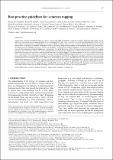Files in this item
Best practice guidelines for cetacean tagging
Item metadata
| dc.contributor.author | Andrews, Russel D. | |
| dc.contributor.author | Baird, Robin W. | |
| dc.contributor.author | Calambokidis, John | |
| dc.contributor.author | Goertz, Caroline E. C. | |
| dc.contributor.author | Gulland, Frances M. D. | |
| dc.contributor.author | Heide-Jorgensen, Mads-Pieter | |
| dc.contributor.author | Hooker, Sascha Kate | |
| dc.contributor.author | Johnson, Mark | |
| dc.contributor.author | Mate, Bruce | |
| dc.contributor.author | Mitani, Yoko | |
| dc.contributor.author | Nowacek, Douglas P. | |
| dc.contributor.author | Owen, Kylie | |
| dc.contributor.author | Quakenbush, Lori T. | |
| dc.contributor.author | Raverty, Stephen | |
| dc.contributor.author | Robbins, Jooke | |
| dc.contributor.author | Schorr, Gregory S. | |
| dc.contributor.author | Shpak, Olga V. | |
| dc.contributor.author | Townsend, Forrest I. | |
| dc.contributor.author | Uhart, Marcela | |
| dc.contributor.author | Wells, Randall S. | |
| dc.contributor.author | Zerbini, Alexandre N. | |
| dc.date.accessioned | 2020-02-05T15:30:10Z | |
| dc.date.available | 2020-02-05T15:30:10Z | |
| dc.date.issued | 2019-12-16 | |
| dc.identifier | 266121667 | |
| dc.identifier | 32012891-01c3-4034-b536-ddabf5c6391a | |
| dc.identifier | 85082676319 | |
| dc.identifier.citation | Andrews , R D , Baird , R W , Calambokidis , J , Goertz , C E C , Gulland , F M D , Heide-Jorgensen , M-P , Hooker , S K , Johnson , M , Mate , B , Mitani , Y , Nowacek , D P , Owen , K , Quakenbush , L T , Raverty , S , Robbins , J , Schorr , G S , Shpak , O V , Townsend , F I , Uhart , M , Wells , R S & Zerbini , A N 2019 , ' Best practice guidelines for cetacean tagging ' , Journal of Cetacean Research and Management , vol. 20 , pp. 27-66 . < https://archive.iwc.int/ > | en |
| dc.identifier.issn | 1561-0713 | |
| dc.identifier.other | ORCID: /0000-0002-7518-3548/work/68280516 | |
| dc.identifier.uri | https://hdl.handle.net/10023/19413 | |
| dc.description.abstract | Animal-borne electronic instruments (tags) are valuable tools for collecting information on cetacean physiology, behaviour and ecology, and for enhancing conservation and management policies for cetacean populations. Tags allow researchers to track the movement patterns, habitat use andother aspects of the behaviour of animals that are otherwise difficult to observe. They can even be used to monitor the physiology of a tagged animal within its changing environment. Such tags are ideal for identifying and predicting responses to anthropogenic threats, thus facilitating the development of robust mitigation measures. With the increasing need for data best provided by tagging and the increasing availability of tags, such research is becoming more common. Tagging can, however, pose risks to the health and welfare of cetaceans and to personnel involved in tagging operations. Here we provide ‘best practice’ recommendations for cetacean tag design, deployment and follow-up assessment of tagged individuals, compiled by biologists and veterinarians with significant experience in cetacean tagging. This paper is intended to serve as a resource to assist tag users, veterinarians, ethics committees and regulatory agency staff in the implementation of high standards of practice, and to promote the training of specialists in this area. Standardised terminology for describing tag design and illustrations of tag types and attachment sites are provided, along with protocols for tag testing and deployment (both remote and through capture-release), including training of operators. The recommendations emphasise the importance of ensuring that tagging is ethically and scientifically justified for a particular project and that tagging only be used to address bona fide research or conservation questions that are best addressed with tagging, as supported by an exploration of alternative methods. Recommendations are provided for minimising effects on individual animals (e.g. through careful selection of the individual, tag design and implant sterilisation) and for improving knowledge of tagging effects on cetaceans through increased post-tagging monitoring. | |
| dc.format.extent | 40 | |
| dc.format.extent | 4062999 | |
| dc.language.iso | eng | |
| dc.relation.ispartof | Journal of Cetacean Research and Management | en |
| dc.subject | Bio-logging | en |
| dc.subject | Radio-tagging | en |
| dc.subject | Satellite tagging | en |
| dc.subject | Telemetry | en |
| dc.subject | GC Oceanography | en |
| dc.subject | QA75 Electronic computers. Computer science | en |
| dc.subject | QH301 Biology | en |
| dc.subject | T Technology | en |
| dc.subject | T-NDAS | en |
| dc.subject.lcc | GC | en |
| dc.subject.lcc | QA75 | en |
| dc.subject.lcc | QH301 | en |
| dc.subject.lcc | T | en |
| dc.title | Best practice guidelines for cetacean tagging | en |
| dc.type | Journal article | en |
| dc.contributor.institution | University of St Andrews. School of Biology | en |
| dc.contributor.institution | University of St Andrews. Scottish Oceans Institute | en |
| dc.contributor.institution | University of St Andrews. Institute of Behavioural and Neural Sciences | en |
| dc.contributor.institution | University of St Andrews. St Andrews Sustainability Institute | en |
| dc.contributor.institution | University of St Andrews. Sea Mammal Research Unit | en |
| dc.contributor.institution | University of St Andrews. Marine Alliance for Science & Technology Scotland | en |
| dc.contributor.institution | University of St Andrews. Bioacoustics group | en |
| dc.contributor.institution | University of St Andrews. Sound Tags Group | en |
| dc.description.status | Peer reviewed | en |
| dc.identifier.url | https://archive.iwc.int/ | en |
This item appears in the following Collection(s)
Items in the St Andrews Research Repository are protected by copyright, with all rights reserved, unless otherwise indicated.

